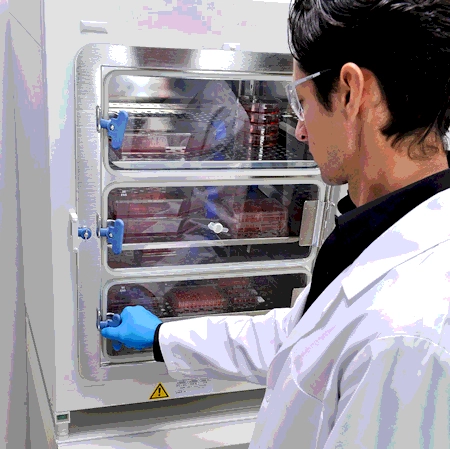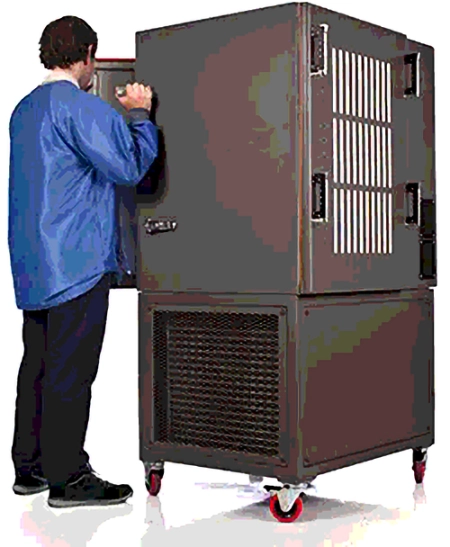Incubators Versus Environmental Chambers: Important Features and Cost Considerations
A Guide to Prices and Cost Considerations for Laboratory Incubators and Environmental Chambers
Prices of laboratory incubators vary according to size, features, and manufacturer specifications. New laboratory incubators range in price from $300 to over $20,000. Used or refurbished units range from $100 to $10,000. Prices of Environmental Chambers range significantly depending on the intended use. Industrial units can cost over $30,000 while smaller research-scale units can cost up to $20,000. Shop for Laboratory Incubators, Environmental Chambers, and Stability Chambers on LabX.com.
Introduction
Laboratory incubators and environmental chambers serve essential roles in scientific research and materials testing. Although both instrument types are designed for climate and environmental control, there are unique features and specifications that are best suited to the intended applications.
What is the difference between laboratory incubators and environmental chambers?
Incubators are used to create a controlled environment in the laboratory for a variety of scientific applications, such as tissue culture, microbial growth, and plant propagation. Environmental chambers, on the other hand, are used to simulate environmental conditions for a variety of industrial, scientific, and testing applications.
What is a laboratory incubator?
 A
laboratory incubator is designed to maintain optimal environmental conditions (e.g.,
temperature, humidity, and CO2 levels) for cell cultures,
microbiology samples, and other biological materials. It is also used to grow,
maintain, and observe microorganisms in a controlled environment.
A
laboratory incubator is designed to maintain optimal environmental conditions (e.g.,
temperature, humidity, and CO2 levels) for cell cultures,
microbiology samples, and other biological materials. It is also used to grow,
maintain, and observe microorganisms in a controlled environment.
There are two main types of incubators - water-jacketed and direct heat. The former uses warm water surrounding the incubator chamber as the primary temperature control. This style benefits from increased temperature uniformity and sustained temperature after a power outage. These units take an extended time to adjust the temperature as compared with direct heat, however, and there is an upper limit on temperature prohibiting high-heat sterilization.
Direct heat incubators use coils located throughout the chamber to directly heat the air. These units typically take a shorter time to warm up and to undergo temperature changes. They can utilize high heat sterilization and are generally lighter than water-jacketed units. One disadvantage is the tendency towards uneven heating and excessive evaporation of samples and tissues.
Laboratory incubator features and specifications
Laboratory incubators can vary widely in terms of features and specifications but typically include the following functionalities:
- Temperature range: Most laboratory incubators feature a temperature range of between 4°C and 60°C, or up to 120°C for certain applications. Advanced systems may have multiple probes to help ensure consistent temperatures throughout the incubator chamber.
- Humidity control: Many lab incubators include humidity control, allowing for precise regulation of atmospheric conditions.
- Exterior door: All incubators feature an exterior door with a sealing mechanism to maintain environmental control or sterility.
- Interior lighting: Some incubators are equipped with interior lighting for easy viewing of sample cultures.
- Shelves: Removeable shelves are typically included to provide a secure surface for sample culture containers and the ability to adjust and accommodate larger items.
- Ventilation: Some incubators include adjustable ventilation to provide adequate air circulation and prevent sample contamination.
- Safety features: Advanced models include safety features, such as over-temperature alarms and automatic shut-off.
- Decontamination: Many incubators include measures such as hot air or UV irradiation to maintain a sterile environment within the incubator.
How much does a laboratory incubator cost?
The price of a laboratory incubator depends on the size, features, and complexity of the model as well as the brand. Basic incubators may range from $1,000 to $5,000, while more advanced and specialized models can cost up to $20,000 or more. Other factors that may affect the cost of a laboratory incubator include energy efficiency, cooling/recovery rate, remote monitoring, and accessories.
Laboratory incubator manufacturers
Thermo Fisher Scientific offers a portfolio of laboratory incubators that range in function from general-purpose to GMP-certified.
- Features of these units include advanced airflow technology which ensures consistent temperature, humidity, and air quality is distributed evenly throughout the cabinets
- Variable oxygen control allows users to choose O2 levels specific to cell types
- Multiple sensor controls provide reliable measurement of environmental factors inside the incubator
- Features include in-chamber HEPA filtration, high-temperature sterilization, touchscreen interfaces, and others
NuAire offers comprehensive systems to create a controlled environment for cell growth while providing protection with a multi-layered defense against contamination.
- Infrared sensors accurately measure CO2 levels regardless of temperatures and humidity
- Adjustable chamber and door heaters ensure uniformity in cabinet temperature
- Stainless steel interiors and ISO 5 level filtered air kept at positive pressure aim to prevent external contamination
- Features include touch panel control, downloadable data monitoring, a range of chamber sizes and dimensions, and the ability to customize units
Binder offers a range of incubators from general-purpose to delicate and demanding cell culturing.
- Advanced air circulation technology prevents the buildup of condensation during use, thereby minimizing the outgrowth of contaminating bacteria and mold
- Homogenous gas distribution and quick mixing ensure consistent levels and steady pH throughout the cabinet
- Stainless steel inner chambers with rounded corners make the units easy to clean and maintain
Memmert offers a suite of incubators including units built for cultivation below room temperature.
- Advanced Peltier technology allows efficient cooling of the interior chamber and an operating temperature range 0° C to +70° C
- Common applications include bacterial analysis and count determination, heat shock experiments, and aging and shelf-life experiments of perishable products.
Other popular laboratory incubator manufacturers include:
What is an environmental chamber?
 An
environmental chamber is a temperature and humidity-controlled laboratory
chamber used for scientific testing and/or materials storage. It is designed to
simulate specific environmental conditions and to test the performance and
durability of materials, products, and components in a variety of conditions. Industrial
applications include automotive, electronics, aerospace, and medical.
An
environmental chamber is a temperature and humidity-controlled laboratory
chamber used for scientific testing and/or materials storage. It is designed to
simulate specific environmental conditions and to test the performance and
durability of materials, products, and components in a variety of conditions. Industrial
applications include automotive, electronics, aerospace, and medical.
Environmental chambers can range in size from small half cubic foot benchtop models to >12,00 cubic foot walk-in rooms. The type of chamber required depends on the products to be tested, the size of the space, and the parameters that need to be investigated.
Temperature only test chambers allow performance of steady-state or temperature cycling tests to evaluate materials or product durability. The temperature within the chamber is accurately controlled over the range -20°C to 94°C within +/- 0.5°C or better.
Temperature and Humidity testing allows real-world conditions to be replicated for analysis of consumer products and electronics. HALT testing (highly accurate life testing) is often used to simulate the complete life span of products. In addition to temperature control, humidity ranges of 20% to 95% relative humidity are typically required.
Environmental chamber features and specifications
Environmental chambers, used to control temperature, humidity, light, oxygen, and other environmental conditions, can also be used to store and handle sensitive materials, such as food and pharmaceuticals. Common features of environmental chambers include:
- Temperature control: Allows for precise temperature control, often within +/- 0.1°C.
- Humidity control: Humidity can be controlled, often within +/- 2%.
- Light control: Allows for the control of light levels, including UV and infrared.
- Oxygen control: Allows for the control of oxygen levels within the chamber.
- Air-flow control: Allows for the control of airflow and air pressure within the chamber.
- Data logging and monitoring: Allows for the logging and monitoring of environmental conditions, such as temperature, humidity, and light levels.
- Safety features: Features such as safety alarms and emergency shut-off valves.
- Construction: Chambers are made from durable materials, such as stainless steel, that are designed to withstand high temperatures and humidity.
Environmental chamber price considerations
The price of an environmental chamber is determined by many factors, including size, temperature range, humidity range, and other features. The brand of the chamber and the quality of the materials and construction will affect the price as well. The more advanced features and automation included, such as data logging, will also increase the cost.
Prices can range from a few hundred dollars for a small, basic chamber to multiple thousands of dollars for large, feature-rich, industrial-scale chambers.
Environmental test chamber manufacturers
Binder offers a wide range of environmental chambers built for research and quality assurance for materials, products, and system testing.
- Units are designed to be perfectly matched to the requirements of quality assurance and development (EN, IEC, or MIL) standards
- Humidity test chambers create the perfect climate for stress, photostability, and stability testing of pharmaceutical ingredients and other materials
- Dynamic climate chambers support standardized testing under dynamic temperature and humidity conditions
- Battery test chambers provide safe testing of lithium-ion cells and modules
Memmert offers a range of climate and humidity chambers, each meeting strict performance and safety standards.
- Constant climate models are designed to meet ICH guidelines for cosmetics, foods, environmental, and materials stability testing
- Humidity chambers create an ideal environment for accelerated life and 85/85 tests
- Environmental test chambers provide the proper conditions for climate storage with CO gasification and a controlled atmosphere
Other environmental chamber manufacturers include:
Summary
Key metrics of laboratory incubators include the ability to achieve the temperature, humidity, and gas concentration levels needed and the ability to maintain consistent levels throughout the incubator interior. Other metrics include fast recovery times after door-opening events and the ability to protect against the growth of mold and bacteria from both interior and external sources. These attributes should be focal points when assessing system cost.
Environmental chambers must maintain temperature, humidity, and gas concentrations or pressure with high accuracy. The size of the unit as well as controls, diagnostics, and alarm monitors have significant bearing on system cost. Buyers should be aware of advanced features such as touchscreen operation, remote tracking, and event logging which can add extended performance and cost to both types of systems.










